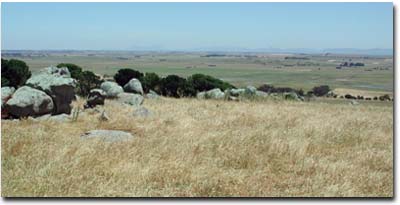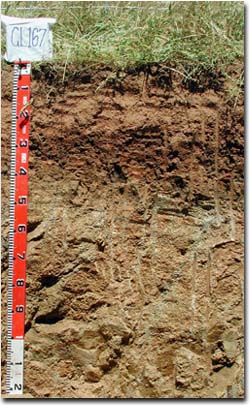Site GL167
Location: Maroona.
Land Mapping Unit: Ararat Granites.
Australian Soil Classification: Mottled, Eutrophic, Brown CHROMOSOL (confidence level 1).
General Land Unit Description:
This land unit consists of granitic hills and rises around Ararat. Granitic tors are common on the crests and at the break of slope in some areas. Landslips are evident on the steeper slopes. This site is situated just off the crest of a low hill. The crest itself has a large amount of large granite tors. The soils are generally shallow, less than 50 cm deep, with a sharp transition to a deeply weathered C horizon. Granite floaters may occur at varying depths. The subsoil structure is prismatic and angular blocky. The dominant soil type is a Grey Sodosol, often found on the lower slopes, e.g. GL168, GL174. Chromosols are more likely to occur on the crests and steeper slopes. Due to the high amounts of rock outcrop at this site, it will have a lower land capability rating than GL168.
 Site GL167 Landscape |
Site Description:
Slope: 5% .
Geology: Ordovician granite.
Landform Pattern: Low Hills.
Position in Landscape: Just off Crest.
Internal Drainage: Well drained.
Soil Profile Morphology:
Surface Soil
| A11 | 0-15 cm | Very dusky red (2.5YR2.5/2); loamy coarse sand; weak fine sub-angular blocky structure; very weak consistence; many small sub-rounded quartz pebbles (2-6 mm); pH 6.2; gradual change to: |  Site GL167 Profile |
| A12 | 15-25 cm | Reddish brown (5YR4/4); loamy coarse sand; many medium prominent dark yellowish brown (10YR3/6) mottles; weak medium sub-angular blocky structure; many small sub-rounded quartz pebbles (2-6 mm); pH 5.7; abrupt change to: | |
| Subsoil | |||
| B2 | 25-40 cm | Reddish brown (2.5YR5/3); medium heavy clay; many prominent medium dark yellowish brown (10YR3/6) mottles; strong medium prismatic, parting to strong medium angular blocky structure; many distinct clay skins present; pH 6.6; clear and wavy change to: | |
| C | 40-120+ cm | Weathered granite. |
Key Profile Features:
- Strong texture contrast between surface (A) horizons and subsoil (B) horizons.
- Shallow soil profile.
- Mottled subsoil.
- Many coarse fragments in surface horizons.
pH | Salinity Rating | |||
Surface (A1 horizon) | Slightly Acid | Low | Non-Sodic | None |
Subsoil (25-40 cm) | Strongly Acid | Low | Non-Sodic | None1 |
 |
Horizon | Horizon Depth (cm) | pH (water) | pH (CaCl2) | EC 1:5 | Exchangeable Aluminium mg/kg | Exchangeable Acidity meq/100g | Exchangeable Cations | |||
Ca | Mg | K | Na | |||||||
meq/100g | ||||||||||
A11 | 0-15 | 6.2 | 5.4 | 0.13 | <10 | 5 | 2.9 | 0.91 | 1.2 | 0.13 |
A12 | 15-25 | 5.7 | 4.7 | 0.08 | 19 | 5.9 | 2.2 | 1.7 | 1.4 | 0.19 |
B21 | 25-40 | 6.6 | 5.9 | 0.15 | 6.4 | 4.6 | 6.6 | 1.9 | 0.62 | |
Horizon | Horizon Depth (cm) | Field Capacity pF2.5 | Wilting Point pF4.2 | Coarse Sand (0.2- 2.0 mm) | Fine Sand (0.02- 0.2 mm) | Silt (0.002- 0.02 mm) | Clay (<0.002 mm) |
A11 | 0-15 | 13 | 5 | 49 | 31 | 7 | 10 |
A12 | 15-25 | 14 | 8 | 38 | 29 | 7 | 24 |
B21 | 25-40 | 25 | 16 | 23 | 21 | 6 | 49 |
Profile Described By: Natalie Baxter, Nathan Robinson, Grant Boyle and Mark Imhof (October 2001).


